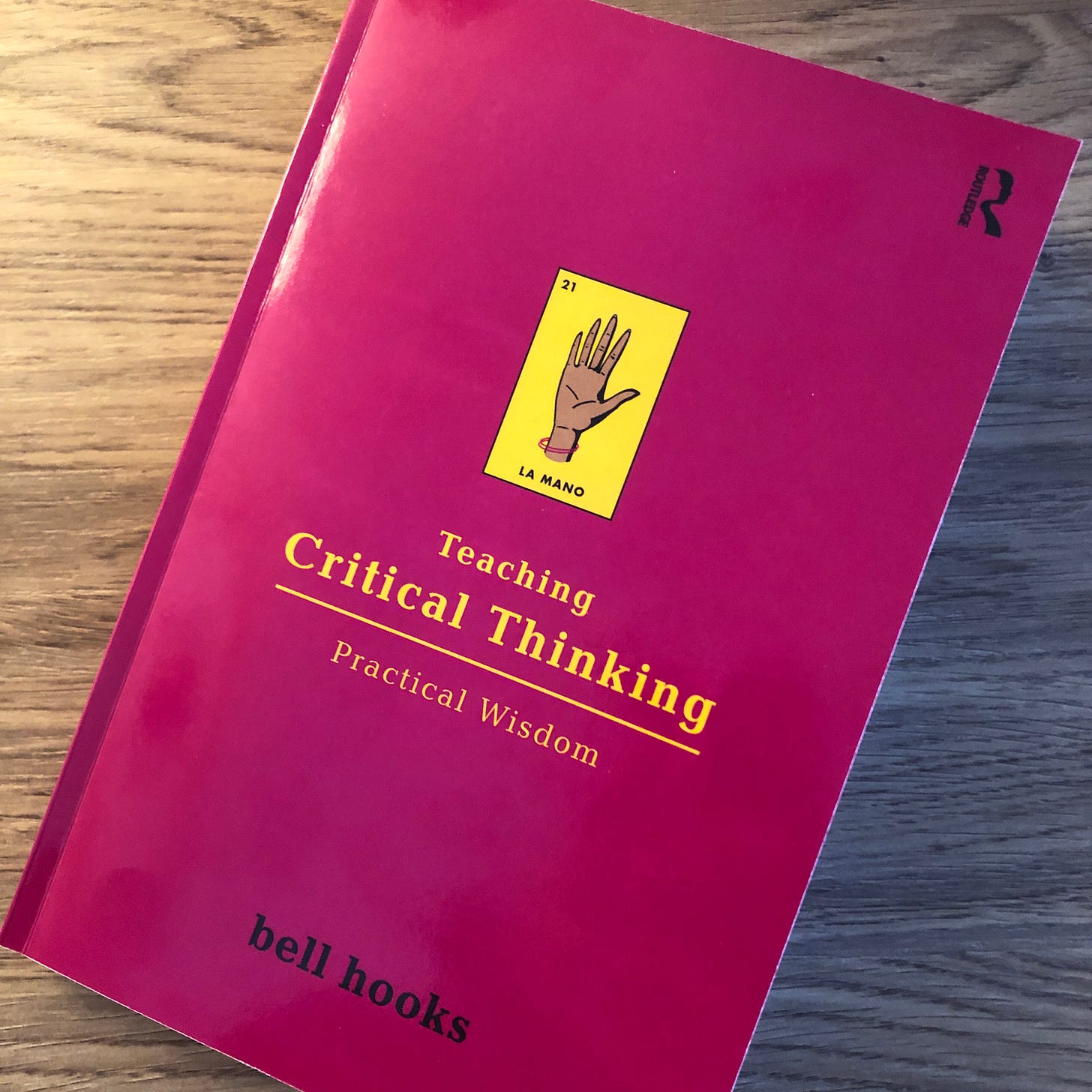81. 🧐 still thinking critically 🧐
thinking about love and self-determination
Hello, and happy Monday.
Last week kicked my butt, and I needed this weekend to rest and recover. As a result, this week’s letter to you will be a little shorter than usual (no “still processing” section), but I hope that you enjoy nonetheless!
📚 Still reading.
Part 3 of 3
hooks, bell. Teaching Critical Thinking: Practical Wisdom. New York: Routledge, 2010.
This week, I’m writing about the final section of bell hooks’s Teaching Critical Thinking. (You can read Part 1 here and Part 2 here.) I have to say, reading bell hooks over the past few weeks has really been a joy. By engaging with her writing on teaching, I have been able to really see it as being in service to my own thinking and learning. I’ve thought about classroom dynamics and how to practice radical openness in the classroom—how to put students in the best position possible to do the work of critical thinking.
I’ve also reflected on my own experiences as a student in undergraduate and graduate courses. I’ve realized that so much of the way that I teach has been informed by the experiences I’ve had in the classroom—about my own desires as a student, and how they were or were not met in the past. This work has been formative for me. I make slight changes here and there in my own pedagogical practice—trying on new modes of operating in the classroom that I think will promote a space of democratic education and critical thinking.
This set of books should be read by teachers and students alike. Although each book in the series begins with the word “Teaching,” so much of hooks’ words are important—necessary, even—for students to hear and embody as they move forward in their own learning journeys. As hooks states in the teaching “To Love Again,”
While teachers in their leadership are in the best position to create a climate of love in the classroom, students have the power to share their love of learning in a manner that can ignite sparks in a teacher who may be emotionally disengaged. No matter the direction from which love emerges in the classroom, it transforms.
And with that, here’s the final installment of my brief reflections. As I wrote last week, I hope that these small reflections and thoughts invite you to check out the book yourself, as there is truly so much to treasure in reading these pieces in their entirety. I hope you enjoy, and please let me know what you think about this series if you happen to read it yourself!
Self-Esteem: Now having read the book in its entirety, I think that this essay might be one of the most important ones. This essay helped me understand the central role that self-esteem plays in one’s ability to be open to learning and critical thinking, particularly for students who are from minoritized communities. “In my early years of university teaching, I, too, was somewhat brainwashed and felt that my central role was to impart knowledge, that it was not my role to be a therapist. Yet it soon became apparent to me that if lack of self-esteem served as a barrier to students’ learning, then I would have to help them to work at removing that barrier so that the information and knowledge I hoped to share could be constructively grasped by them,” (125).
The Joy of Reading: In this essay, hooks speaks on the ways that she sees our current society as treating books like consumer objects rather than as treasured artifacts. She also points to the importance of independent bookstores and feminist bookstores in distributing dissident opinions that would not be carried at corporatized bookstores. Basically, this essay comes down to: support independent bookstores, and use your public library. Access to these spaces is critical for our continued work of thinking beyond our current societal systems.
Intellectual Life: hooks speaks on the reasons why she chose to pursue an intellectual life—one filled with passion for ideas and critical thinking—in a fundamentally anti-intellectual society. She also teases out the ways in which cultural criticism is generally misunderstood as coming from a place of attack, rather than seeing it as pushing dialogue and consciousness further. “When the subject matter a critic works with and the conclusions drawn from that work have direct consequences for how we live in the world, the critic is much more likely to be regarded negatively. This is especially the case when working with issues of race, gender, and sexuality. It is especially the case when an aspect of one’s critical work requires the interrogation and even the dismantling of previously held assumptions...when we are knowledge that requires listeners to shift their paradigms there is almost always a letting go that is difficult and painful,” (137-138).
Writing Books for Children: Using her children’s books Happy To Be Nappy and Be Boy Buzz as examples, hooks reflects on the productive power of writing to decolonize the minds of children from an early age. It speaks to the importance of representations that address children’s whole selves, particularly black children and children of color. When thinking about Happy To be Nappy, hooks writes, “It afforded me a way to think outside the box, to imagine ways of talking and thinking positively, joyfully about black girls and our hair,” (142).
Spirituality: Defining spirituality as “concerned with those qualities of the human spirit—such as love and compassion, patience, tolerance, forgiveness, contentment, a sense of responsibility, a sense of harmony—which brings happiness to both self and others,” hooks argues for the importance of spirituality in the classroom. If we understand that part of the work of education is to be a practice of healing, then by seeing it as spiritual, we are acknowledging the work of learning in making one more whole. “Spirituality belongs in the classroom because it is the seemingly magical force that allows for the radical openness that is needed for genuine academic and/or intellectual growth,” (150).
To Love Again: This essay is all about the place of love in the classroom—love being “a combination of care, commitment, knowledge, responsibility, respect, and trust,” (159). Ultimately, hooks argues, love is in the classroom whenever there is a passion for learning and knowledge among students and teachers. Recognizing love’s place in teaching and learning is critical to changing our larger educational systems towards democratic and progressive practices.
Feminist Change: Speaking of love, this essay is a meditation on the understanding that self-love is foundational to our search for love elsewhere, particularly if we want to love as feminists.
Moving Past Race and Gender: In this dedication to the work and ideas of Black feminist writers, hooks concludes with the importance of love in the intellectual work of these thinkers. “It is essential to our struggle for self-determination that we speak of love, as love is the necessary foundation enabling us to survive the wars, the hardships, and the sickness and the dying with our spirits intact. It is love that allows us to survive whole...it is the most militant, most radical intervention anyone can make to not only speak of love, but to engage in the practice of love. For love as the foundation of all social movements for self-determination is the only way we create a world that domination and dominator thinking cannot destroy,” (176).
Teaching as Prophetic Vocation: This essay ties many of the previous themes together. It connects the practice of critical thinking to the embodiment of self-determination. It then follows that the classroom as a space for learning the skill of critical thinking is necessary to understanding the whole of one’s self. “the more I teach, the more I learn that teaching is a prophetic vocation. It demands of us allegiance to integrity of vision and belief in the face of those who would either seek to silence, censor, or discredit our words,” (181).
Practical Wisdom: Honestly, I can’t really do this essay justice in a small space. This is my invitation to you to grab a copy and read it for yourself! ❣️
🌀 Still consuming.
Absolutely WHEEZING at the above tweet.
For someone who chronically watched morning routine YouTube videos in college, this was very sobering for me. Heheh
I really want to know more about Margaret Wise, the author of the children’s book Goodnight Moon.
Basically in love with everything that Sheila Heti does.
📖 Book club corner.
For February’s book club, we will be reading bell hooks’s All About Love: New Visions. I am so excited! Feel free to purchase the book here, and the details are below!
Here’s the event info:
Date & Time: February 22 at 5PM PST/8PM EST
Registration link!
Suggested Donation (for those able to donate): $3-10 through Paypal or Venmo (@idyalz)
If you'd like to learn more about the tiny driver book club, click here!
🐶 A pup-date.
Girlie’s been practicing her camouflaging skills recently:
As always, thanks so much for reading through, and I'll see you in the next one!
Warmly,
Ida





